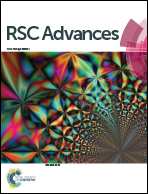Deep insights into the growth pattern of palladium nanocubes with controllable sizes†
Abstract
Although shape and size controllable palladium nanocrystals have attracted enormous attention, the growth behavior of Pd nanocubes is not thoroughly understood. In this work, the growth pattern of size controllable Pd nanocubes is studied systematically under a variety of reaction conditions. During the growth process of the Pd nanocubes, various structures including concave cubes, triangular bipyramids, pentagonal bipyramids (decahedrons) and pentagonal rods can be generated due to the disparate behavior of the fresh Pd atoms. Different-sized nanocubes are prepared controllably by changing the dosage of KBr, which provides capping capacities toward the {100} facets that the cubes are enclosed with. Both ascorbic acid (AA) and KBr influence the reducing rate of the Pd precursors and the growth kinetics of the nanocrystals, and furthermore control the morphologies of the products. This detailed research supplements the understanding of crystal growth, and provides insight toward the comprehension of atom movements at the nanoscale.


 Please wait while we load your content...
Please wait while we load your content...